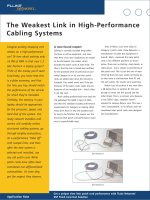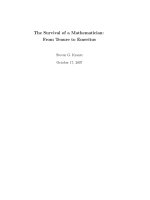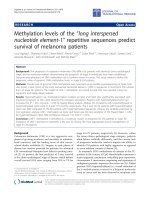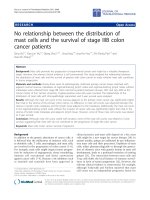The survival of the weakest
Bạn đang xem bản rút gọn của tài liệu. Xem và tải ngay bản đầy đủ của tài liệu tại đây (81.31 KB, 14 trang )
8 The survival of the weakest
The thrust of this book is that pressures and stresses on peripheral populations
in areas of population growth have driven the changes that have marked human
biological and cultural evolution. It has been the stressed populations that have
been the most innovative (e.g. Fitzhugh, 2001). Hominids have responded to the
increasing instability with risk reduction responses that fit under the umbrella
of increasing the spatio-temporal scale of operation. Correlates of increase in
scale have included, as we saw in Chapter 5, an increase in dispersal ability,
home range size, group size, neocortex size, the complexity of social behaviour,
symbolism, efficient and mobile tool kits, and gracile morphology. Since global
climate and environments have become increasingly unstable over the last two
million years those marginal populations that adapted to local stresses in these
ways were able to turn disadvantage into advantage each time conditions dete-
riorated or became less stable. These adaptations would have evolved in periph-
eral populations that perceived marginal landscapes as spatially heterogeneous
and therefore spatially risky. These adaptations to exploiting patchy landscapes
then became advantageous in situations of increasing temporal heterogeneity,
that is in situations that were perceived as temporally risky. We can therefore
understand these adaptations as evolving through a normal process of natural
selection and we do not need to invoke alternative mechanisms, such as variabil-
ity selection (Potts, 1996a, b, 1998), to explain the observed patterns and trends.
Most of these adaptations would have been behavioural. However, directional
trends towards increasing patchiness also permitted morphological adaptations
such as limb morphology and neocortex size. Temporary, low-scale, climatic
and environmental improvements would have reversed the situation. We do
not know how many innovations subsequently became ‘extinct’ as no trace of
them would have been left in the archaeological record. The apparent halt of
the progress of the early Moderns in the Middle East after 100 kyr may be an
example of such a reversal. Had the global situation changed towards increasing
stability the picture today may well have been very different as conservative
behaviour would have been favoured over innovation. Let us briefly look at
large scale technological change to illustrate this point.
195
196 Neanderthals and Modern Humans
Technological innovation
Technology is the result of: (a) ecology, in response to the environment; and (b)
history, the product of traditions and their diffusion (Chapter 5). The changes
that we observe in the archaeological record, that take us from Mode 1 to
Mode 4 technology, do not reflect a linear evolution. Reversals, in cases of
the discarding of more sophisticated technology in favour of more rudimentary
forms are not infrequent. The adoption of a particular technology is the balance
between its costs and the benefits gained from its use. A costly technology may
be adopted if it brings gains that far exceed the costs. If circumstances change
and the benefits are reduced, the particular technology may be discarded in
favour of a less costly form. The apparent increase in technological complexity
through time is a reflection of cumulative historical effects and not of a linear,
progressive, technological evolution. What we do expect to observe through
time, in a world of increasing instability, is the development of technologies that
were increasingly costly to make but that were also increasingly beneficial in
unstable circumstances. What we would expect to increase is their efficiency –
that is, the differential between the energetic costs of manufacture and the
benefits derived from their use. I propose that the trend from Mode 1 to Mode 4
is one that goes from low cost/low benefit/low efficiency technologies towards
high cost/high benefit/high efficiency ones. We see this degree of sophistication
in the late Upper Palaeolithic technology, such as the light and highly specialised
microblades of north-east Asia and north-west North America that facilitated
the rapid re-colonisation of Siberia after the Last Glacial Maximum (LGM)
around 18 kyr (Goebel et al., 2000).
Mode 1, the earliest technology that was employed by the early forms of
Homo (attributed to ergaster, erectus, antecessor), was an economical and lo-
cal technology. There was no requirement to cover large distances to obtain
particular raw materials. Tools were made in situ and discarded once used.
In the particular circumstances of early Pleistocene Africa, a relatively stable
climate but more unstable than previously, this tool kit was advantageous in per-
mitting greater options of resource exploitation. The hominids that practised
this technology thrived and Mode 1 spread, permitting the bearers to breach the
tropical barrier for the first time. The process of spread was slow. By the time
Mode 1 reached Eurasia it was in an evolved form (Carbonell et al., 1999a).
The next technological mode to appear was Mode 2, associated with the
production of bifacial tools and with early (ergaster) and evolved (heidelber-
gensis) forms. Mode 2 had no clear advantage over Mode 1 as the two survived
in parallel for 1 Myr. We have no knowledge of whether groups of hominids
alternated between these two technological modes depending on ecological cir-
cumstances. Because Mode 2 required particular types of raw materials, which
Survival of the weakest 197
required specific searches that had not been needed for Mode 1 and because
there were costs involved in manufacture, we have to assume that this was a
more costly technology than Mode 1. In the type of conditions in which Mode
1 evolved, the more costly Mode 2 would have been at a disadvantage which is
probably why it took some time for it to become widespread and why Mode 1
was often used instead when the two options were available. How would Mode
2 have originated? In my view Mode 2 would have arisen in peripheral tropical
African populations that were more stressed than core populations using Mode
1. As Mode 1 populations expanded it would have been the peripheral popu-
lations, in sub-optimal habitats, that would have had to increase their scale of
operation to reduce risk of extinction. Living in increasingly patchy landscapes
in terms of their preferred resources these populations would have become
wider ranging. A portable kit, like Mode 2, though more costly would have
been increasingly advantageous. It would have been the product of increased
innovation under increasing stress. Why did Mode 2 not evolve, then, among
the Eurasian populations that would have been under even greater stress? These
Eurasian Mode 1 populations would have been at much lower densities so it
is unlikely that they would have reached the densities that created the kinds
of demographic pressure that affected the African populations. The low den-
sity would have statistically reduced the chances of innovations appearing and
spreading. So, in Eurasia, we would expect thinly spread populations continuing
with Mode 1.
As the world became increasingly unstable and all populations adopted a
more highly mobile form of living, Mode 1 became extinct and Mode 2 survived.
The rapid spread of Mode 2 in Europe in an evolved form, after a significant
delay in arrival, is perhaps the first example of the ecological release followed
by rapid spread that, as we have seen, characterised later human populations.
The delay in arrival in Europe, in spite of the greater mobility and dispersal
capacity of these populations may reflect worsening environmental conditions
that slowed down the rate of spread. We can thus envisage a situation, starting
with the bearers of Mode 1, in which dispersal out from Africa is achieved
under relatively benign conditions by slow dispersing hominids. Increasingly
harsh conditions would have slowed the rate of dispersal of later populations
but this would have been counteracted by increased dispersal capacities and
more versatile technology. The result is that hominids kept dispersing out from
Africa. A further prediction of this model is that, as dispersal ability and tech-
nological versatility improved, populations dispersing from Africa should have
been increasingly able to expand the range further than previous dispersing
populations, turning former barriers into corridors. This prediction would ap-
pear to be met. Bearers of Mode 1 dispersed across tropical and sub-tropical
regions of Eurasia including the Mediterranean. Bearers of Mode 2 reached
198 Neanderthals and Modern Humans
areas of temperate western Europe. Bearers of Mode 3 expanded further into
areas of Eurasia. Bearers of Mode 4 were the first to colonise the Eurasian Plain
and reach North America. I am not making any distinction as to the biological
identity of the bearers of these technologies nor indeed whether the different
modes dispersed with populations or simply spread through cultural transmis-
sion. The net effect is the same – bearers of Mode 4 colonised the largest areas
of the planet and bearers of Mode 1 the smallest.
The sobering conclusion that I derive is that it has been the peripheral popula-
tions, those in some way weaker and displaced by density-dependent processes,
that have adapted to situations of increased risk. As the world has become an in-
creasingly risky place so these populations have been at an advantage and have
spread while the less versatile core populations have lost out. This need not be
the result of competitive processes. It is far more likely that less versatile popu-
lations were reduced and eliminated by instability and others, better able to deal
with instability, moved in then to become core populations in their own right,
with a slowed rate of change. New peripheral populations then went through
a process of increasing adaptive versatility and the process was repeated all
over again. The last cases would have included the extinction of the so-called
‘archaic’ populations (including the Neanderthals), starting as on all previous
occasions with those in tropical Africa, and the filling of the empty space left
by them by the peripheral Moderns.
Most discussions of the relationship between Moderns and the Neanderthals
end with the Neanderthal extinction that is put at around 30–28 kyr in the last
sites (Chapter 7). Clearly Neanderthals must have survived somewhat later as
these dates are for sites in which the Neanderthal population density must have
been high enough for the archaeological record to detect it. It is na¨ıve to think of
these as the latest dates of Neanderthal survival. Even so, we can agree that the
last Neanderthal populations probably became extinct before the onset of the
LGM, at some point towards the end of OIS 3. So, at the onset of the LGM we
have a world that is apparently, in Eurasia at least, inhabited only by Moderns.
So what happened to these Moderns?
The last glacial maximum
I will focus this discussion on the European and Middle Eastern picture as it is the
best documented. With the onset of the LGM and the advance of the ice sheets
(Chapter 6) much of Europe was inhospitable to humans (Housley et al., 1997;
Bocquet-Appel & Demars, 2000a). We observe a pattern of human dispersion
that is not dissimilar to that of earlier cold events, except that on this occasion
it is Moderns and not Neanderthals that are involved. The heightening of the
Survival of the weakest 199
LGM sees the intrusion of temperate environments well into the Mediterranean
refugia, most so in the continental peninsulas of the Balkans and Italy, and
also across much of the central Iberian tablelands. Steppe dominates these
plains and montane vegetation descends even in the thermo-Mediterranean
coastal belt. Steppic species reach far south, with mammoth reaching the latitude
of Granada in Spain (37
◦
N) and woolly rhinoceros, reindeer and wolverine
reaching well into central Iberia (Garcia & Arsuaga, 2003). The worsening
of conditions at the end of OIS 3 saw the corresponding expansion of plains
adapted humans across the Eurasian Plain (Chapter 7), first with Aurignacian
technology and then with Gravettian technology. Towards the start of the LGM
these populations became highly dispersed and fragmented in the Eurasian
Plains and many local populations would have become extinct. Instead there is
a population demographic explosion in the southern refugia, at least within the
Iberian Peninsula and parts of south-western France. This increase is related to
people carrying a new technology (the Solutrean) that appears adapted to the
exploitation of open vegetation plains fauna with long-range weapons (Straus
et al., 2000). The increase corresponds to the expansion of steppic environments
in Iberia. Some authors have connected this population increase with the decline
in the Eurasian Plain, suggesting southward displacement of these populations.
Although there may have been an element of southward dispersal as populations
retreated, I think that it is more likely that these populations simply were unable
to adapt fast enough to the change and went extinct. At the same time those that
had penetrated Iberia were adapted to steppe and their populations expanded.
This scenario is not dissimilar to those that Neanderthals would have faced
in previous glaciations with one exception. For the first time we have steppe-
adapted populations of humans within the refugia able to capitalise on the
spread of these habitats. But we saw in Chapter 5 that one difference between
Moderns and Neanderthals was that the former could also exploit heterogeneous
environments. So the people of the Solutrean were also able to survive along
the coastal mountains of Cantabria and the Mediterranean coast of Iberia.
The last deglaciation
The deglaciation was marked by a demographic explosion (Demars, 1996;
Bocquet-Appel & Demars, 2000a) and by the expansion of humans from
southern and eastern refugia into the Eurasian Plains as the ice sheets receded
(Aldhouse-Green & Pettitt, 1998; Torroni et al., 1998, 2001; Street & Terberger,
1999; Blockley et al., 2000; Semino et al., 2000). The size of Iberia meant that
it probably held the largest population of humans in Europe, so it is not sur-
prising to see the extent of their subsequent genetic influence as they spread









